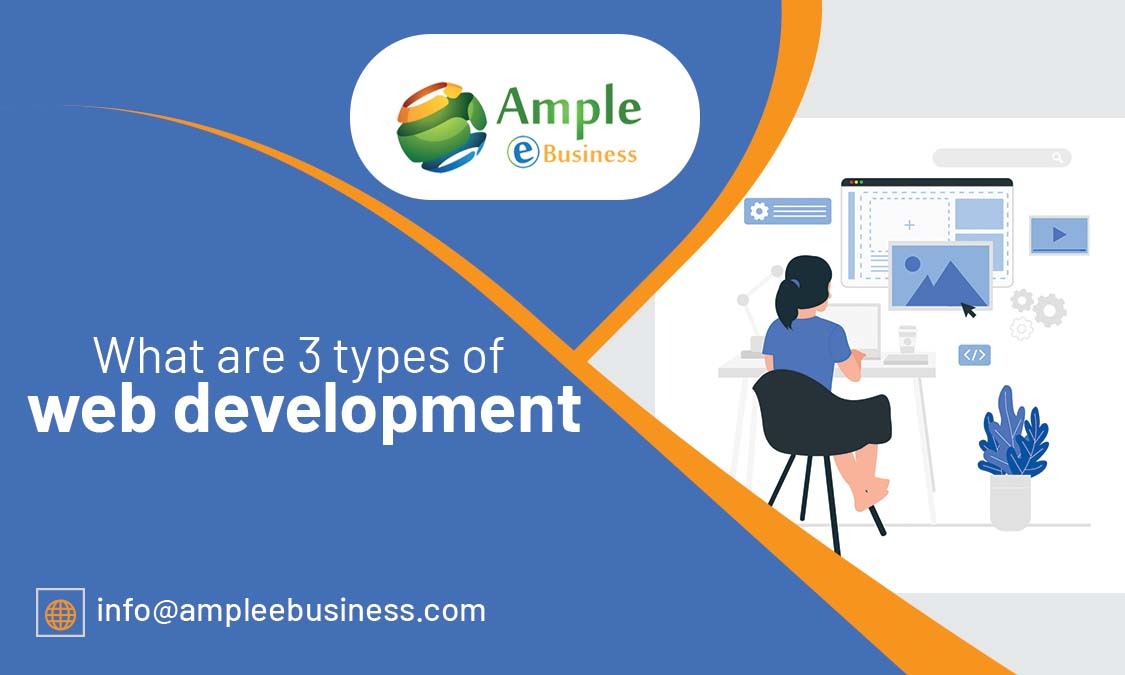
For a computer science major, becoming a web developer is one of the most intriguing career paths because it combines analytical and technical skills with creative design and development. Working with experts in IT, sales, and marketing, web developers create websites that draw in and retain customers, boosting a company’s sales or a government agency’s efficiency.
Ample eBusiness is here to educate you about the three types of web development and how you can go about using them effectively.
What are the three types of web development?
Based on the components and technologies used to create websites and web applications, web development includes a number of specialized fields. Following are the three main categories of web development:
1) Front-End Development
The process of developing the graphical and interactive components of a website or web application that users interact with directly is referred to as front-end development, also known as client-side development. Front-end developers use a variety of technologies to create a user interface (UI) for websites that is appealing, practical, and easy to use. Their job is to make the design and user experience come to life. The main elements and tools used in front-end development are listed below:
a) Hypertext Markup Language (HTML):
• The fundamental component of web pages is HTML. In addition to defining headings, paragraphs, images, links, and other elements, it also provides the website’s structure and content.
• Front-end developers use HTML to build a website’s semantic structure, ensuring that it is accessible, well-organized, and simple for both users and search engines to understand.
b) Cascaded Style Sheets (CSS):
• The presentation and layout of an HTML-created web page are controlled by CSS. It enables front-end developers to specify styles for responsive design, color, font, spacing, and positioning.
• With CSS, programmers can design user interfaces that look good and behave consistently on a variety of screens and devices.
c) JavaScript:
• Web pages can now be interactive and dynamic thanks to JavaScript, a potent scripting language. It gives front-end developers the ability to make interactive elements, animations, and user interfaces that react to user input.
• JavaScript is used by front-end developers to implement client-side features like form validation, pop-ups, sliders, and more.
d) Front-End Frameworks and Libraries:
• Front-end frameworks and libraries are frequently used by front-end developers to speed up development and take advantage of pre-made features and components. Angular, React, and Vue.js are a few well-known frameworks.
• Common JavaScript interactions and tasks are made simpler by libraries like jQuery, which facilitate the development of effective code.
e) Design that Adapts:
• Websites that are responsive—that is, ones that adapt to and display properly on different devices like desktops, laptops, tablets, and smartphones—are created by front-end developers.
• To achieve responsive design, media queries, and adaptable layouts are used, giving users the best viewing experience possible on any device.
2) Back-End Programming
Back-end development, also referred to as server-side development, entails building the logic and functionality of a website or web application that is used in the background and is not directly accessed by users but is necessary for the site to function properly. Back-end developers are in charge of server administration, database management, and data processing tasks. The main elements and technologies used in back-end development are listed below:
a) Languages used on the server:
• The server-side logic is implemented by back-end developers using server-side programming languages like Python, Ruby, PHP, Java, Node.js, and others.
• These languages manage user requests, handle data processing, and produce dynamic front-end content.
b) Databases:
• Data used by the web application is stored and managed by back-end developers using databases. MySQL, PostgreSQL, MongoDB, and SQL Server are examples of popular database management systems.
• They create queries to retrieve and update data, design the database schema, and guarantee the security and integrity of the data.
c) Website Hosts:
• The communication between the client-side and server-side components is handled by web servers like Apache, Nginx, and Microsoft IIS.
• In order to ensure effective handling of user requests and accurate delivery of responses, back-end developers configure and manage web servers.
d) APIs (Application Programming Interfaces):
• APIs allow data exchange and communication between various software systems. Front-end components can communicate with server-side functionalities thanks to APIs that back-end developers build and maintain.
• APIs are essential for connecting to databases, integrating third-party services, and facilitating data sharing between different web application components.
e) Identity Verification and Security:
• To ensure that users can access the correct features and data based on their roles and permissions, back-end developers implement user authentication and authorization systems.
• Input validation, data encryption, and defense against widespread web application vulnerabilities like SQL injection and cross-site scripting (XSS) are also handled by them.
3) Full-Stack Development
A comprehensive method of web development known as “full-stack development” allows programmers to work on both the front-end and back-end elements of a website or web application. An expert in many different technologies, a full-stack developer can handle every step of the development process, from creating user interfaces to handling databases and server-side logic. An outline of what full-stack development entails is provided below:
a) Front-End Development (Client-Side): Full-stack developers have the skills necessary to work with front-end technologies like HTML, CSS, and JavaScript to develop aesthetically pleasing and user-friendly interfaces. They are able to create responsive layouts, put interactive features in place, and guarantee a good user experience.
b) Back-End Development (server-side): Full-stack programmers are skilled at writing server-side code in a variety of programming languages, including Python, Ruby, PHP, Java, or Node.js. They are able to manage servers, put business logic into place, work with databases to store and retrieve data for the web application, and manage servers.
c) Databases and Data Management: Full-stack developers are capable of creating and managing databases, ensuring effective data manipulation, storage, and retrieval. The database management systems MySQL, PostgreSQL, MongoDB, and others are all ones they are familiar with.
d) APIs and Integration: Full-stack developers can create and use APIs (Application Programming Interfaces) to facilitate data exchange and communication between various components of a web application or external services. They can incorporate services and APIs from outside parties into the application.
e) Server Configuration and Deployment: Full-stack developers can install and configure web servers (such as Apache and Nginx) as well as deploy web applications to hosting environments, ensuring that the application is usable by internet users.
f) Version Control: Full-stack developers are skilled at working with version control tools like Git, which enables them to efficiently manage and collaborate on code changes.
In order to create successful websites and web applications, each type of web development is essential. Some developers focus on just one of these areas, while others may work as full-stack developers who handle every step of the development process. You can contact Ample eBusiness with any query.

